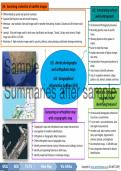Summary
Summary Grade 12 Geography Summaries Topic 1 & 2 (Term 1) - Via Afrika
- Course
- Geography
- Institution
- 12th Grade
Grade 12 Geography Summaries Topic 1 & 2 (Term 1). This summaries are composed using the Via Afrika textbooks' work with examples and supplementary notes. This product also contains the summaries for Geographic skills and Techniques (Terms 1 - 4). Contents: Geographical Skills and Techniqu...
[Show more]



